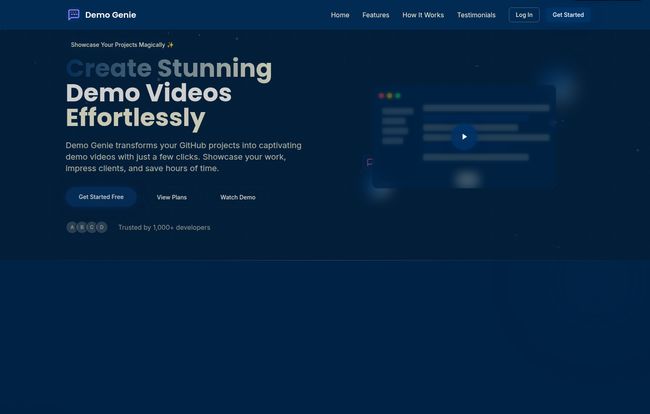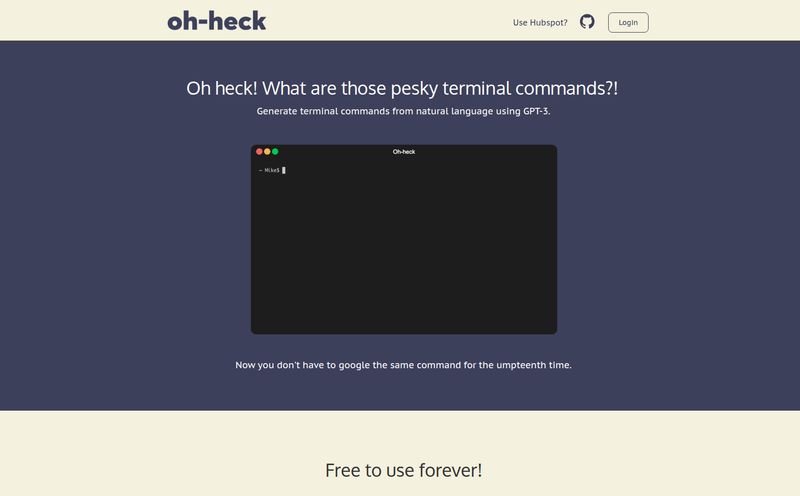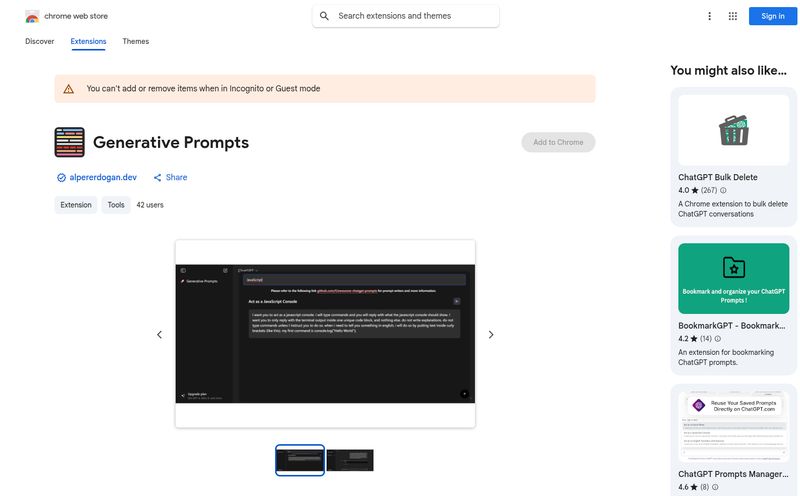If you're a developer, a project manager, or an indie hacker, what's the one task you dread more than untangling a legacy CSS file? For me, it’s making demo videos.
You know the drill. You finally push a brilliant new feature. You're riding the high of a successful commit. And then it hits you: you have to show it to someone. The client, the team, your mom... someone. So out comes the screen recording software. You clear your throat, stumble over your words, realize your desktop is a mess of old files, and then spend the next hour trying to edit out the ums, ahs, and the moment your cat jumped on the keyboard.
It’s a time sink. A soul-crushing, momentum-killing time sink.
So when I stumbled across a tool called DemoGenie, my cynical SEO-blogger heart skipped a beat. A tool that promises "Stunning Demo Videos in a Flash" by connecting directly to your GitHub repo and using AI to do the heavy lifting? Okay, you have my attention. I had to see if it was just another shiny new toy or something that could genuinely give me back my Saturday afternoons.

Visit DemoGenie
So, What Exactly is This DemoGenie Thing?
At its core, DemoGenie is a clever little platform designed to take the grunt work out of creating product demos. Instead of you manually recording your screen, it connects to your GitHub repository, peeks at your latest code updates, and then uses AI to generate a professional-looking interactive demo.
The magic part? You don't need a degree in video editing. You just describe what you want to showcase in plain English. Something like, "Show the new user login flow, then highlight the updated dashboard widgets." The AI takes that prompt and generates a slick video that walks through the feature. It feels a bit like summoning a tiny, caffeinated video editor who lives inside your repo and is always ready to go.
Getting Your Hands Dirty with DemoGenie
The onboarding process is refreshingly simple, which I always appreciate. No 20-step setup or weird dependencies to install.
It all starts with your GitHub account, which is a requirement. For most of us in the dev space, that’s a non-issue. You connect DemoGenie to your account, grant it access to the repository you want to work with, and you're pretty much ready to roll.
Once connected, you pick a commit or a feature branch. This is the "before and after" that your video will be based on. Then comes the fun part: telling the AI what to do. You write out a simple description. My first attempt was something clunky like, “uh, make a video about the button change.” To my surprise, it actually worked. It generated a short clip that zoomed in on the old button, then the new one, with some nice transitions. It’s not Shakespeare, but it gets the point across in seconds.
The generated videos can then be shared with a simple link, which is perfect for dropping into a Slack channel, a project management ticket, or an email to a client who needs to see progress right now.
The Features That Actually Matter
A lot of new tools throw a kitchen sink of features at you. DemoGenie is refreshingly focused. Here's what stood out to me.
The GitHub Integration is Killer
This isn't just a gimmick; it's the core of what makes the tool so smart. By integrating directly with GitHub, DemoGenie has context. It understands what code changed, which files were affected, and can more intelligently build the visual narrative. This is lightyears ahead of just a dumb screen recorder. It means the demos are grounded in actual development work, not just a performance you're putting on.
AI-Powered Descriptions Feel Like a Shortcut
The ability to use natural language is huge. It lowers the barrier to entry completely. You don’t have to learn a proprietary scripting language or fiddle with a complex timeline editor.
I’ve always felt that the best tools are the ones that get out of your way and let you focus on the outcome. This is one of them.
Now, is it perfect? Not quite. The AI is good, but sometimes it needs a little guidance. You might have to rephrase your description to get the emphasis just right. But a little fine-tuning is a small price to pay for avoiding a two-hour editing session in Premiere Pro.
Is It Really a Time Saver? My Honest Take
So, the big question: does it actually deliver on its promise to "save hours of time"? In my experience, yes. Absolutely.
Think about the usual workflow. Recording, re-recording, editing, compressing, uploading… it's easily an hour or more for a simple two-minute demo. With DemoGenie, I was creating shareable demos in about five to ten minutes, most of which was me just thinking about how to best describe the feature.
Of course, it’s not all sunshine and roses. The reliance on AI means you give up a bit of granular control. If you're a video pro who needs every single pixel to be perfect and every transition timed to the millisecond, this might feel a bit restrictive. Also, the fact that you need a GitHub account might be a hurdle for some non-technical folks, but frankly, this tool isn't really for them.
Here's a quick rundown of what I liked and what I think could be improved:
What I Loved:
The speed is just incredible. Going from "code pushed" to "demo ready" in minutes is a game-changer for agile teams. The quality of the output is also surprisingly professional, with clean graphics and smooth animations. And the free plan for personal projects? A massive win. It lets you kick the tires and use it for your open-source work without dropping a dime.
Room for Improvement:
For very complex, multi-step user flows, the AI might need a few tries to get it right. I'm also curious to see how the paid plans will be structured, as the website is a bit light on details right now. A bit more customisation on branding (like adding your own logos or color schemes) would be a fantastic addition for agencies and larger teams.
Let's Talk Money: The DemoGenie Pricing
Okay, the part everyone scrolls down to first. How much does this magic cost?
As of right now, DemoGenie is promoting a very generous Free plan. The site says it's "Free for personal projects. No credit card required." This is brilliant. It means you can use it for your personal portfolio, your open-source contributions, or just to try it out on a side project without any commitment.
The "View Plans" button suggests there are, or will be, paid tiers. I'd speculate these will be aimed at commercial use, teams, and enterprises, likely offering features like:
- Unlimited private repositories
- Team collaboration features
- Custom branding options
- Higher usage limits
For now, though, the free offering is solid enough for a huge chunk of the potential user base, especially solo developers and small teams. It’s a smart move to build a user base first.
Who is This Tool Really For?
After playing around with it, I have a pretty clear idea of who will fall in love with DemoGenie:
- Indie Hackers & Solo Founders: You're building, marketing, and selling all by yourself. Shaving hours off your workflow is like finding gold. This is a massive productivity boost.
- Freelance Developers: You need to show progress to clients constantly. Sending a slick, professional demo instead of a clunky screen recording makes you look so much better.
- Open-Source Maintainers: Creating demos for new features can help with adoption and community engagement. A free tool to help with that is invaluable.
- Agile Development Teams: Perfect for quickly sharing progress during a sprint or for internal review without having to schedule a formal meeting.
If you're a massive enterprise with a dedicated video production team, this might not replace your polished marketing videos. But for the day-to-day grind of showing and telling? It’s a perfect fit.
Frequently Asked Questions about DemoGenie
I've seen a few questions pop up, so let's tackle them head-on.
Do I need to be a developer to use DemoGenie?
While it's built around GitHub, you don't need to be a hardcore coder. If you can write a descriptive sentence and understand the basics of a repository, you can use it. A project manager who's comfortable in GitHub could easily create demos.
What kind of videos can it create?
It excels at creating short, feature-focused videos. Think "showcasing a new UI element," "demonstrating an API endpoint," or "walking through a bug fix." It's not designed for long-form tutorials or marketing epics.
Can I edit the videos after they are generated?
The editing is primarily done by refining your text prompt. It's not a traditional video editor where you can drag and drop clips on a timeline. The idea is to automate that part away.
Is it secure to connect my private GitHub repositories?
This is always a valid concern. DemoGenie, like many other developer tools that use GitHub OAuth, uses standard, secure protocols to access your repositories. You grant it specific permissions. For any mission-critical, super-secret project, you should always review the permissions and privacy policy of any third-party app.
How does the free plan work?
The free plan is designed for personal, non-commercial projects. This is perfect for students, open-source developers, or anyone wanting to build a public portfolio. Commercial projects would likely require a future paid plan.
My Final Take: Is DemoGenie a Keeper?
Yes. Without a doubt.
DemoGenie isn't just another tool; it’s a solution to a problem that plagues almost everyone in the software development lifecycle. It takes a tedious, often-procrastinated task and makes it fast, easy, and even a little bit fun. It’s a fantastic example of using AI for practical automation, not just hype.
It's not going to put video editors out of a job, but it will democratize the ability to create clean, effective demo videos. It bridges the gap between finishing the work and showing off the work. For any developer or team looking to move faster and communicate better, giving DemoGenie a spin isn't just a good idea—it feels almost necessary. I've bookmarked it, and I have a feeling it's going to be a regular part of my workflow from now on.
Reference and Sources
- DemoGenie Official Website: https://demogenie.dev/
- DemoGenie Pricing Information: https://demogenie.dev/#
- GitHub Website: https://github.com/



